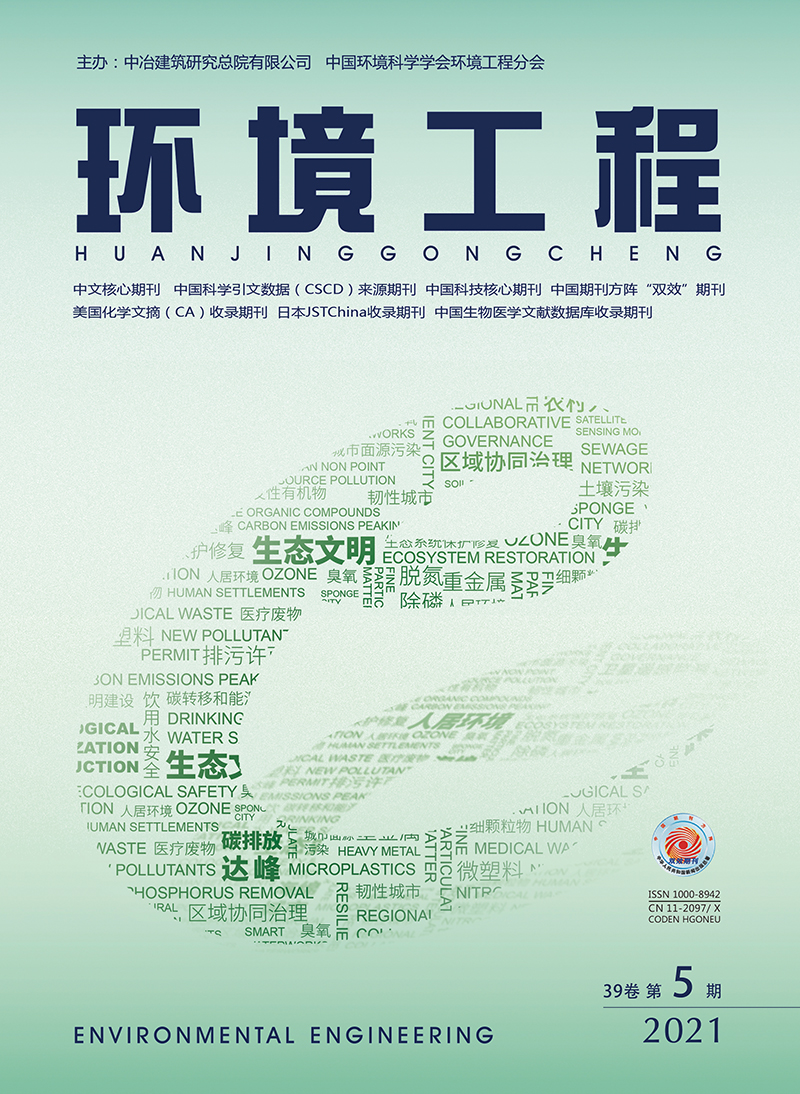| [1] |
DIXIT R, WASIULLAH, MALAVIYA D, et al. Bioremediation of heavy metals from soil and aquatic environment:an overview of principles and criteria of fundamental processes[J]. Sustainability, 2015, 7(2):2189-2212.
|
| [2] |
曹心德,魏晓欣,代革联,等. 土壤重金属复合污染及其化学钝化修复技术研究进展[J]. 环境工程学报, 2011, 5(7):1441-1453.
|
| [3] |
WANG M M, REN L S, WANG D Y, et al. Assessing the capacity of biochar to stabilize copper and lead in contaminated sediments using chemical and extraction methods[J]. Journal of Environmental Sciences (China), 2019, 79:91-99.
|
| [4] |
CAI M F, MCBRIDE M B, LI K M, et al. Bioaccessibility of As and Pb in orchard and urban soils amended with phosphate, Fe oxide and organic matter[J]. Chemosphere, 2017, 173:153-159.
|
| [5] |
付煜恒, 张惠灵, 王宇, 等. 磷酸盐对铅镉复合污染土壤的钝化研究[J]. 环境工程, 2017, 35(9):176-180.
|
| [6] |
LIU W G, WEI D Z, MI J Y, et al. Immobilization of Cu(Ⅱ) and Zn(Ⅱ) in simulated polluted soil using sulfurizing agent[J]. Chemical Engineering Journal, 2015, 277:312-317.
|
| [7] |
MAHAR A, WANG P, LI R H, et al. Immobilization of lead and cadmium in contaminated soil using amendments:a review[J]. Pedosphere, 2015, 25(4):555-568.
|
| [8] |
SEVIOUR T, DERLON N, DUEHOLM M S, et al. Extracellular polymeric substances of biofilms:suffering from an identity crisis[J]. Water Research, 2019, 151:1-7.
|
| [9] |
MORE T T, YADAV J S S, YAN S, et al. Extracellular polymeric substances of bacteria and their potential environmental applications[J]. Journal of Environmental Management, 2014, 144:1-25.
|
| [10] |
WEI L L, LI Y, NOGUERA D R, et al. Adsorption of Cu2+ and Zn2+ by extracellular polymeric substances (EPS) in different sludges:effect of EPS fractional polarity on binding mechanism[J]. Journal of Hazardous Materials, 2017, 321:473-483.
|
| [11] |
SIVAPERUMAL P, KAMALA K, RAJARAM R. Adsorption of cesium ion by marine actinobacterium nocardiopsis sp. 13H and their extracellular polymeric substances (EPS) role in bioremediation[J]. Environmental Science and Pollution Research, 2018, 25(5):4254-4267.
|
| [12] |
NKOH J N, XU R K, YAN J, et al. Mechanism of Cu(Ⅱ) and Cd(Ⅱ) immobilization by extracellular polymeric substances (Escherichia coli) on variable charge soils[J]. Environmental Pollution, 2019, 247:136-145.
|
| [13] |
KRANTHI Raj K, USHA R S, ERRAVELLI B, et al. Advances in exopolysaccharides based bioremediation of heavy metals in soil and water:a critical review[J]. Carbohydrate Polymers, 2018, 199:353-364.
|
| [14] |
VILLEN G M, PAZ G J M, AMAYA Santos G, et al. Effects of the buffering capacity of the soil on the mobilization of heavy metals. Equilibrium and kinetics[J]. Chemosphere, 2015, 131:78-84.
|
| [15] |
GEOGHEGAN M J, BRIAN R C. Aggregate formation in soil:1. influence of some bacterial polysaccharides on the binding of soil particles[J]. Biochemical Journal, 1948, 43:5-13.
|
| [16] |
MIKUTTA R, BAUMGÄRTNER A, SCHIPPERS A, et al. Extracellular polymeric substances from Bacillus subtilis associated with minerals modify the extent and rate of heavy metal sorption[J]. Environmental Science & Technology, 2012, 46(7):3866-3873.
|
| [17] |
XU Y, LIANG X F, XU Y M, et al. Remediation of heavy metal-polluted agricultural soils using clay minerals:a review[J]. Pedosphere, 2017, 27(2):193-204.
|
| [18] |
FRØLUND B, PALMGREN R, KEIDING K, et al. Extraction of extracellular polymers from activated sludge using a cation exchange resin[J]. Water Research, 1996, 30:1749-1758.
|
| [19] |
LI W W, YU H Q. Insight into the roles of microbial extracellular polymer substances in metal biosorption[J]. Bioresource Technology, 2014, 160:15-23.
|
| [20] |
BRADFORD M M. A rapid and sensitive method for the quantification of microgram quantities of protein utilizing the principle of proteinedye binding[J]. Analytical Biochemistry, 1976, 76(1/2):248-254.
|
| [21] |
GERHARDT P, MURRAY R G E, WOOD W A, et al. Methods for general and molecular bacteriology[M]. Washington, DC:American Society for Microbiology, 1994.
|
| [22] |
SKIDMORE W D, DUGGAN E L, GONZALES L J. Determination of the total phosphorus content of deoxyribonucleic acids in the presence of ethylene glycol by a hydrolysis method[J]. Analytical Biochemistry, 1964, 9:370-376.
|
| [23] |
GABARRON M, ZORNOZA R, MARTINEZ-Martinez S, et al. Effect of land use and soil properties in the feasibility of two sequential extraction procedures for metals fractionation[J]. Chemosphere, 2019, 218:266-272.
|
| [24] |
RAURET G, LÓPEZ-SÁNCHEZ J F, SAHUQUILLO A, et al. Improvement of the BCR three-step sequential extraction procedure prior to the certification of new sediment and soil reference materials[J]. Journal of Environmental Monitoring, 1999, 1:57-61.
|
| [25] |
HU S P, CHEN X C, SHI J Y, et al. Particle-facilitated lead and arsenic transport in abandoned mine sites soil influenced by simulated acid rain[J]. Chemosphere, 2008, 71(11):2091-2097.
|
| [26] |
JOHN S R, MARGARET E F, MIROSLAV C, et al. Differences in lead bioavailability between a smelting and a mining Area[J]. Water,Air, and Aoil Pollution, 2000, 122(1/2):203-229.
|
| [27] |
MEHLICH A. Mehlich 3 soil test extractant:a modification of mehlich 2 extractant[J]. Communications in Soil Science and Plant Analysis, 1984, 15(12):1409-1416.
|
| [28] |
LI N J, ZHANG X H, WANG D Q, et al. Contribution characteristics of the in situ extracellular polymeric substances (EPS) in phanerochaete chrysosporium to Pb immobilization[J]. Bioprocess and Biosystems Engineering, 2017, 40(10):1447-1452.
|
| [29] |
FANG L C, YANG S S, HUANG Q Y, et al. Biosorption mechanisms of Cu(Ⅱ) by extracellular polymeric substances from bacillus subtilis[J]. Chemical Geology, 2014, 386:143-151.
|
| [30] |
KWIATKOWSKA-MALINA J. Functions of organic matter in polluted soils:the effect of organic amendments on phytoavailability of heavy metals[J]. Applied Soil Ecology, 2018, 123:542-545.
|
| [31] |
PERELOMOV L, SARKAR B, RAHMAN M M, et al. Uptake of lead by Na-exchanged and Al-pillared bentonite in the presence of organic acids with different functional groups[J]. Applied Clay Science, 2016, 119:417-423.
|
| [32] |
LIN D, MA W T, JIN Z X, et al. Interactions of EPS with soil minerals:a combination study by ITC and CLSM[J]. Colloids and Surfaces B:Biointerfaces, 2016, 138:10-16.
|
| [33] |
ASH C, TEJNECKY V, SEBEK O, et al. Redistribution of cadmium and lead fractions in contaminated soil samples due to experimental leaching[J]. Geoderma, 2015, 241:126-135.
|
| [34] |
LANDROT G, KHAOKAEW S. Lead speciation and association with organic matter in various particle-size fractions of contaminated soils[J]. Environmental Science & Technology, 2018, 52(12):6780-6788.
|
| [35] |
杨洁,瞿攀,王金生,等. 土壤中重金属的生物有效性分析方法及其影响因素综述[J]. 环境污染与防治, 2017, 39(2):217-223.
|
| [36] |
LIANG S, GUAN D X, LI J, et al. Effect of aging on bioaccessibility of arsenic and lead in soils[J]. Chemosphere, 2016, 151:94-100.
|
| [37] |
BASHIR S, SHAABAN M, HUSSAIN Q, et al. Influence of organic and inorganic passivators on Cd and Pb stabilization and microbial biomass in a contaminated paddy soil[J]. Journal of Soils and Sediments, 2018, 18(9):2948-2959.
|
| [38] |
ABD A A, LEE B T, HAN H J, et al. Assessment of the stabilization of heavy metal contaminants in soils using chemical leaching and an earthworm bioassay[J]. Environmental Geochemstry and Health, 2019, 41(1):447-460.
|
| [39] |
PLUNKETT S A, WIJAYAWARDENA M A A, NAIDU R, et al. Use of routine soil tests to estimate Pb bioaccessibility[J]. Environmental Science & Technology, 2018, 52(21):12556-12562.
|
| [40] |
LIU J H, LI H, WU R P, et al. Effect of weathered coal on the leaching behavior of lead-contaminated soil with simulated acid rain[J]. Water, Air, and Soil Pollution, 2016, 227(10):361.1-361.12.
|
| [41] |
CARMELA I, ANTONELLO B, NICOLETTA C, et al. Bioaccessibility of metals in soils:comparison between chemical extractions and in vitro tests[J]. Chemistry and Ecology, 2014, 30(6):541-554.
|


 Login
Login Register
Register E-alert
E-alert






 DownLoad:
DownLoad: